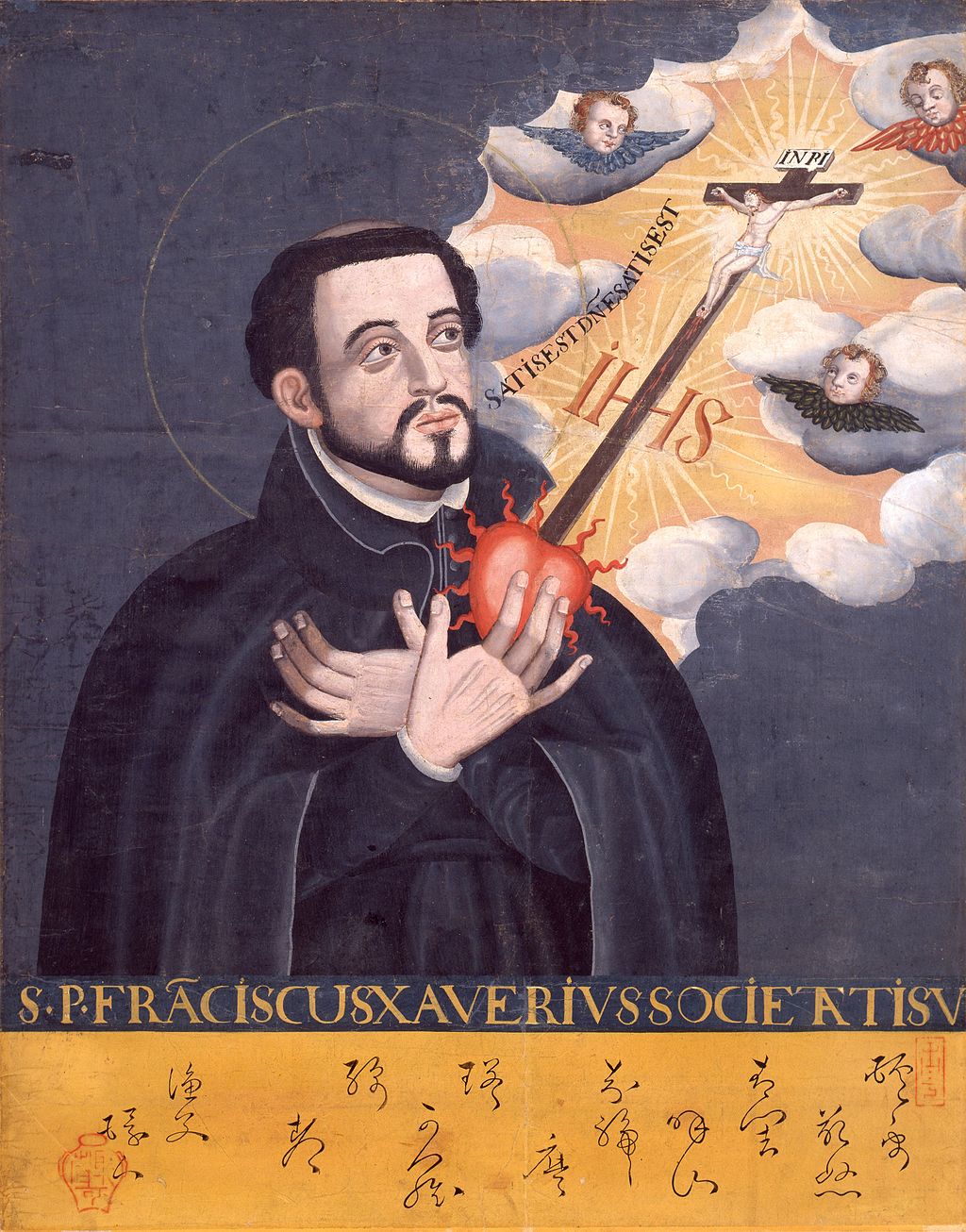
フランシスコ・ザビエル
Francis
Xavier, 1506-1552
☆ フランシスコ・ザビエルSJ(フランシスコ・デ・ジャッソ・イ・アスピリクエタ生まれ: Franciscus Xaverius; Basque: バスク語: Frantzisko Xabierkoa; French: フランソワ・ザビエル、スペイン語:Francisco Javier: フランシスコ・ザビエル; ポルトガル語: フランシスコ・ザビエル、1506年4月7日-1552年12月3日)は、スペインのカトリック宣教師、聖人で、イエズス会を共同設立し、ポルトガル帝国 の代表として、日本への最初のキリスト教伝道を指揮した。
| Francis Xavier,
SJ (born Francisco de Jasso y Azpilicueta; Latin: Franciscus Xaverius;
Basque: Frantzisko Xabierkoa; French: François Xavier; Spanish:
Francisco Javier; Portuguese: Francisco Xavier; 7 April 1506 – 3
December 1552), venerated as Saint Francis Xavier, was a Spanish
Catholic missionary and saint who co-founded the Society of Jesus and,
as a representative of Portuguese empire, led the first Christian
mission to Japan. Born in the town of Xavier, Spain, he was a companion of Ignatius of Loyola and one of the first seven Jesuits who took vows of poverty and chastity at Montmartre, Paris in 1534.[3] He led an extensive mission into Asia, mainly the Portuguese Empire in the East, and was influential in evangelisation work, most notably in early modern India. He was extensively involved in the missionary activity in Portuguese India. In 1546, Francis Xavier proposed the establishment of the Goan Inquisition in a letter addressed to the Portuguese King, John III.[4][5][6][7] While some sources claim that he actually asked for a special minister whose sole office would be to further Christianity in Goa,[8] others disagree with this assertion.[9] As a representative of the king of Portugal, he was also the first major Christian missionary to venture into Borneo, the Maluku Islands, Japan, and other areas. In those areas, struggling to learn the local languages and in the face of opposition, he had less success than he had enjoyed in India. Xavier was about to extend his 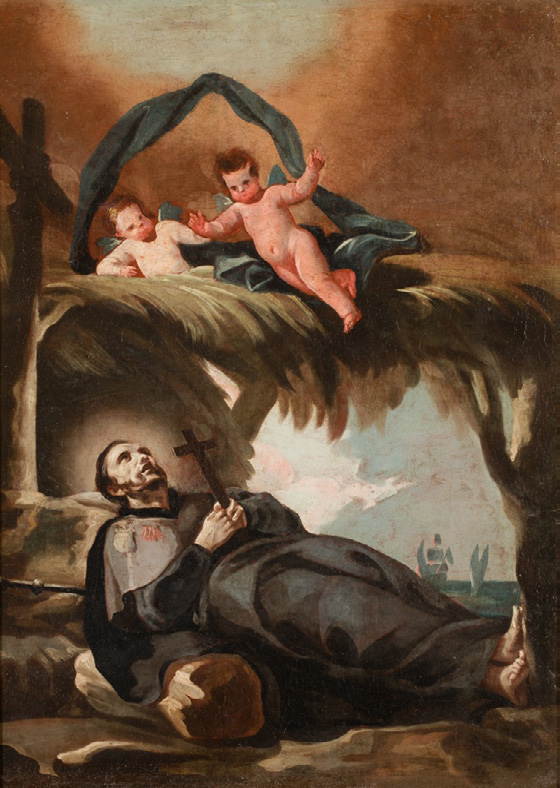 mission to
Ming China, when he died on Shangchuan Island. mission to
Ming China, when he died on Shangchuan Island.He was beatified by Pope Paul V on 25 October 1619 and canonized by Pope Gregory XV on 12 March 1622. In 1624, he was made co-patron of Navarre. Known as the "Apostle of the Indies", "Apostle of the Far East", "Apostle of China" and "Apostle of Japan", he is considered to be one of the greatest missionaries since Paul the Apostle.[10] In 1927, Pope Pius XI published the decree "Apostolicorum in Missionibus" naming Francis Xavier, along with Thérèse of Lisieux, co-patron of all foreign missions.[11] He is now co-patron saint of Navarre, with Fermin. The Day of Navarre in Navarre, Spain, marks the anniversary of Francis Xavier's death, on 3 December. |
フ
ランシスコ・ザビエルSJ(フランシスコ・デ・ジャッソ・イ・アスピリクエタ生まれ: Franciscus Xaverius; Basque:
バスク語: Frantzisko Xabierkoa; French: フランソワ・ザビエル、スペイン語:Francisco Javier:
フランシスコ・ザビエル; ポルトガル語:
フランシスコ・ザビエル、1506年4月7日-1552年12月3日)は、スペインのカトリック宣教師、聖人で、イエズス会を共同設立し、ポルトガル帝国
の代表として、日本への最初のキリスト教伝道を指揮した。 スペインのザビエル町に生まれ、ロヨラのイグナチオの仲間であり、1534年にパリのモンマルトルで清貧と貞潔の誓いを立てた最初の7人のイエズス会の一 人であった[3]。東方のポルトガル帝国を中心にアジアへの広範な宣教を指導し、特に近世インドでの伝道活動に大きな影響を与えた。彼はポルトガル領イン ドでの布教活動に広く関わった。1546年、フランシスコ・ザビエルはポルトガル国 王ヨハネ3世に宛てた書簡の中で、ゴア異端審問所の設立を提案した[4][5][6][7]。実際にゴアにおけるキリスト教の布教を唯一の 職務とする特別聖職者の設置を求めたとする資料もあるが[8]、この主張には異論もある[9]。ポ ルトガル国王の代理人として、ボルネオ、マルク諸島、日本などに進出した最初の主要なキリスト教宣教師でもあった。これらの地域では、現地の言語を習得す るのに苦労し、反対運動にも直面したため、インドで味わったほどの成功を収めることはできなかった。ザビエルは明の中国にも宣教を拡大しようとしていた が、上川島(Shangchuan Island)で亡くなった。  1619
年10月25日に教皇パウロ5世によって列福され、1622年3月12日に教皇グレゴリウス15世によって列聖された。1624年、ナバラの共同庇護者と
なる。インド諸島の使徒"、"極東の使徒"、"中国の使徒"、"日本の使徒
"として知られ、使徒パウロ以来の偉大な宣教師の一人とされている[10]。
1927年、教皇ピオ11世は、リジューのテレーズとともに、フランシスコ・ザヴィエをすべての外国宣教の共同守護者に指名する勅令
『Apostolicorum in Missionibus』を発表した[11]。
現在、フェルミンとともにナバラの共同守護聖人となっている。スペインのナバラでは、フランシスコ・ザビエルの命日である12月3日を「ナバラの日」とし
ている。 1619
年10月25日に教皇パウロ5世によって列福され、1622年3月12日に教皇グレゴリウス15世によって列聖された。1624年、ナバラの共同庇護者と
なる。インド諸島の使徒"、"極東の使徒"、"中国の使徒"、"日本の使徒
"として知られ、使徒パウロ以来の偉大な宣教師の一人とされている[10]。
1927年、教皇ピオ11世は、リジューのテレーズとともに、フランシスコ・ザヴィエをすべての外国宣教の共同守護者に指名する勅令
『Apostolicorum in Missionibus』を発表した[11]。
現在、フェルミンとともにナバラの共同守護聖人となっている。スペインのナバラでは、フランシスコ・ザビエルの命日である12月3日を「ナバラの日」とし
ている。 |
| Early life The castle of the Xavier family was later acquired by the Society of Jesus. Francis Xavier was born in the Castle of Xavier, in the Kingdom of Navarre, on 7 April 1506 into an influential noble family. He was the youngest son of Don Juan de Jasso y Atondo, Lord of Idocín, president of the Royal Council of the Kingdom of Navarre, and seneschal of the Castle of Xavier (a doctor in law by the University of Bologna,[12] belonging to a prosperous noble family of Saint-Jean-Pied-de-Port, later privy counsellor and finance minister to King John III of Navarre)[13] and Doña María de Azpilcueta y Aznárez, sole heiress to the Castle of Xavier (related to the theologian and philosopher Martín de Azpilcueta).[14] His brother Miguel de Jasso (later known as Miguel de Javier) became Lord of Xavier and Idocín at the death of his parents (a direct ancestor of the Counts of Javier). Basque[15] and Romance[16] were his two mother tongues. In 1512, Ferdinand, King of Aragon and regent of Castile, invaded Navarre, initiating a war that lasted over 18 years. Three years later, Francis's father died when Francis was only nine years old. In 1516, Francis's brothers participated in a failed Navarrese-French attempt to expel the Spanish invaders from the kingdom. The Spanish Governor, Cardinal Cisneros, confiscated the family lands, demolished the outer wall, the gates, and two towers of the family castle, and filled in the moat. In addition, the height of the keep was reduced by half.[17] Only the family residence inside the castle was left. In 1522, one of Francis's brothers participated with 200 Navarrese nobles in dogged but failed resistance against the Castilian Count of Miranda in Amaiur, Baztan, the last Navarrese territorial position south of the Pyrenees. In 1525, Francis went to study in Paris at the Collège Sainte-Barbe, University of Paris, where he spent the next eleven years.[18] In the early days he acquired some reputation as an athlete[19] and a high-jumper.[20] In 1529, Francis shared lodgings with his friend Pierre Favre. A new student, Ignatius of Loyola, came to room with them.[21] At 38, Ignatius was much older than Pierre and Francis, who were both 23 at the time. Ignatius convinced Pierre to become a priest, but was unable to convince Francis, who had aspirations of worldly advancement. At first, Francis regarded the new lodger as a joke and was sarcastic about his efforts to convert students.[22] When Pierre left their lodgings to visit his family and Ignatius was alone with Francis, he was able to slowly break down Francis's resistance.[23] According to most biographies Ignatius is said to have posed the question: "What will it profit a man to gain the whole world, and lose his own soul?"[24] However, according to James Broderick such method is not characteristic of Ignatius and there is no evidence that he employed it at all.[22] In 1530, Francis received the degree of Master of Arts, and afterwards taught Aristotelian philosophy at Beauvais College, University of Paris.[22] |
初期の生活 ザビエル家の城は、後にイエズス会によって買収された。 フランシスコ・ザビエルは1506年4月7日、ナバラ王国のザビエル城で有力な貴族の家に生まれた。イドシン領主、ナバラ王国王室会議議長、ザビエル城の 元老院長であったドン・フアン・デ・ジャッソ・イ・アトンド(ボローニャ大学法学博士[12]、サン=ジャン=ピエ=ド=ポールの裕福な貴族に属する)の 末子であった、 後にナバラ王ジョン3世の枢密顧問官兼財務大臣)[13]と、ザビエル城の唯一の相続人ドーニャ・マリア・デ・アスピルクエタ・イ・アズナレス(神学者・ 哲学者のマルティン・デ・アスピルクエタと親戚関係)[14]。 [14]弟のミゲル・デ・ジャッソ(後のミゲル・デ・ハビエル)は、両親の死後、ザビエルとイドシンの領主となった(ハビエル伯爵家の直接の祖先)。バス ク語[15]とロマンス語[16]を母語とした。 1512年、アラゴン王でカスティーリャの摂政であったフェルディナンドがナバラに侵攻し、18年以上続く戦争が始まった。その3年後、フランシスコの父 はフランシスコがまだ9歳のときに亡くなった。1516年、フランシスコの兄弟は、スペインの侵略者を王国から追放しようとしたナバラとフランスの試みに 参加したが失敗した。スペイン総督シスネロス枢機卿は一族の土地を没収し、一族の城の外壁、門、2つの塔を取り壊し、堀を埋めた。さらに、天守閣の高さは 半分に減らされた[17]。城内に残されたのは一族の住居のみであった。1522年、フランシスコの兄弟の一人は、200人のナバラ貴族とともに、ピレ ネー以南のナバラ最後の領土であったバズタン県アマイウルで、カスティーリャのミランダ伯爵に対する執拗な抵抗に参加したが失敗した。 1525年、フランシスコはパリのパリ大学サント・バルブ校に留学し、その後11年間を過ごす[18]。 1529年、フランシスコは友人のピエール・ファーブルと下宿を共にする。38歳のイグナティウスは、当時23歳だったピエールとフランシスコよりもはる かに年上だった。イグナティウスはピエールに司祭になるよう説得したが、世俗的な出世を望んでいたフランシスコを説得することはできなかった。当初、フラ ンシスコは新しい下宿人を冗談とみなし、学生を改宗させようとする彼の努力を皮肉った[22]。ピエールが家族を訪ねるために下宿を離れ、イグナティウス がフランシスコと二人きりになったとき、彼はフランシスコの抵抗を徐々に崩すことができた[23]。ほとんどの伝記によると、イグナティウスはこう問いか けたと言われている: 「しかし、ジェームズ・ブロデリックによれば、そのような方法はイグナチオの特徴ではなく、彼がそれを用いたという証拠はまったくない[22]。 1530年、フランシスコは修士号を取得し、その後パリ大学ボーヴェ・カレッジでアリストテレス哲学を教えていた[22]。 |
Missionary work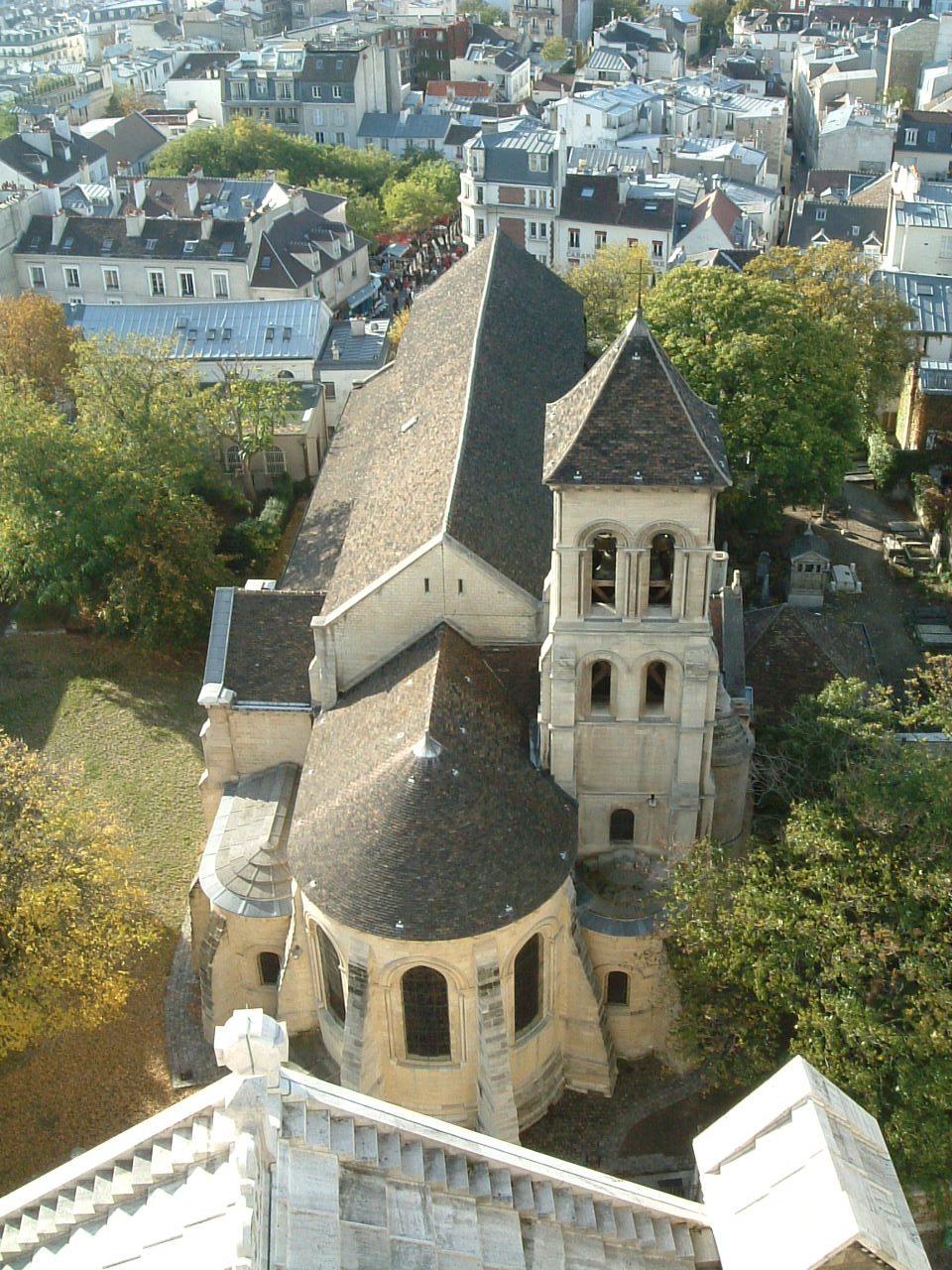 Church of Saint-Pierre de Montmartre, Paris On 15 August 1534, seven students met in a crypt beneath the Church of Saint Denis (now Saint Pierre de Montmartre), on the hill of Montmartre, overlooking Paris. They were Francis, Ignatius of Loyola, Alfonso Salmeron, Diego Laínez, Nicolás Bobadilla from Spain, Peter Faber from Savoy, and Simão Rodrigues from Portugal. They made private vows of poverty, chastity, and obedience to the Pope, and also vowed to go to the Holy Land to convert infidels.[25][26] Francis began his study of theology in 1534 and was ordained on 24 June 1537. In 1539, after long discussions, Ignatius drew up a formula for a new religious order, the Society of Jesus (the Jesuits).[23] Ignatius's plan for the order was approved by Pope Paul III in 1540.[27] In 1540, King John of Portugal had Pedro Mascarenhas, Portuguese ambassador to the Holy See, request Jesuit missionaries to spread the faith in his new possessions in India, where the king believed that Christian values were eroding among the Portuguese. After successive appeals to the Pope asking for missionaries for the East Indies under the Padroado agreement, John III was encouraged by Diogo de Gouveia, rector of the Collège Sainte-Barbe, to recruit the newly graduated students who had established the Society of Jesus.[28] 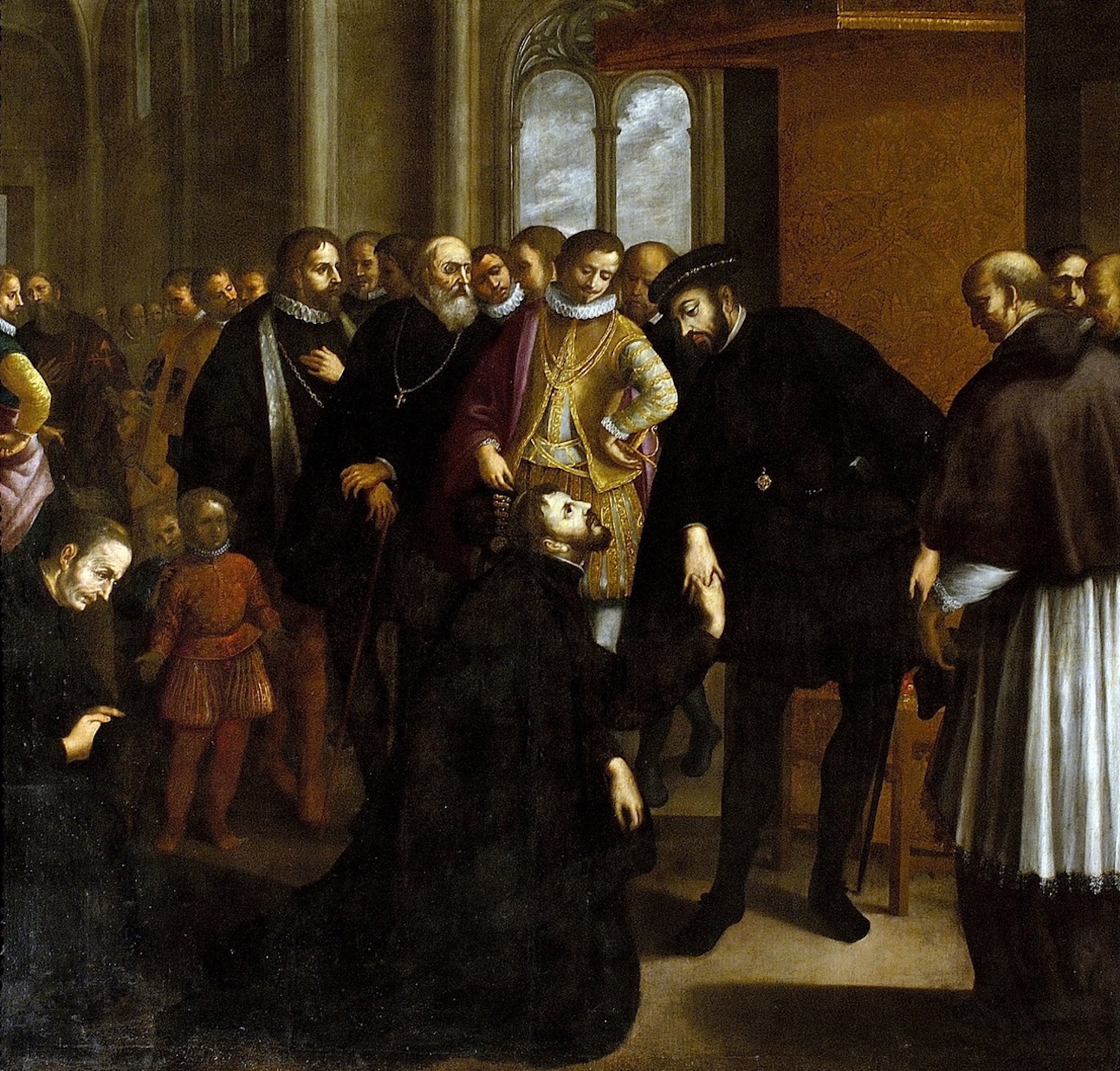 Francisco Xavier taking leave of John III of Portugal for an expedition, by José Avelar Rebelo Ignatius promptly appointed Nicholas Bobadilla and Simão Rodrigues. At the last moment, however, Bobadilla became seriously ill. With some hesitance and uneasiness, Ignatius asked Francis to go in Bobadilla's place. Thus, Francis Xavier began his life as the first Jesuit missionary almost accidentally.[29][30][31] Leaving Rome on 15 March 1540, in the Ambassador's train,[32] Francis took with him a breviary, a catechism, and De Institutione bene vivendi by Croatian humanist Marko Marulić,[33] a Latin book that had become popular in the Counter-Reformation. According to a 1549 letter of F. Balthasar Gago from Goa, it was the only book that Francis read or studied.[34] Francis reached Lisbon in June 1540 and, four days after his arrival, he and Rodrigues were summoned to a private audience with the King and the Queen.[35] Francis Xavier devoted much of his life to missions in Asia, mainly in four centres: Malacca, Amboina and Ternate (in the Maluku Islands of Indonesia), Japan, and off-shore China. His growing information about new places indicated to him that he had to go to what he understood were centres of influence for the whole region. China loomed large from his days in India. Japan was particularly attractive because of its culture. For him, these areas were interconnected; they could not be evangelised separately.[36] Goa and India 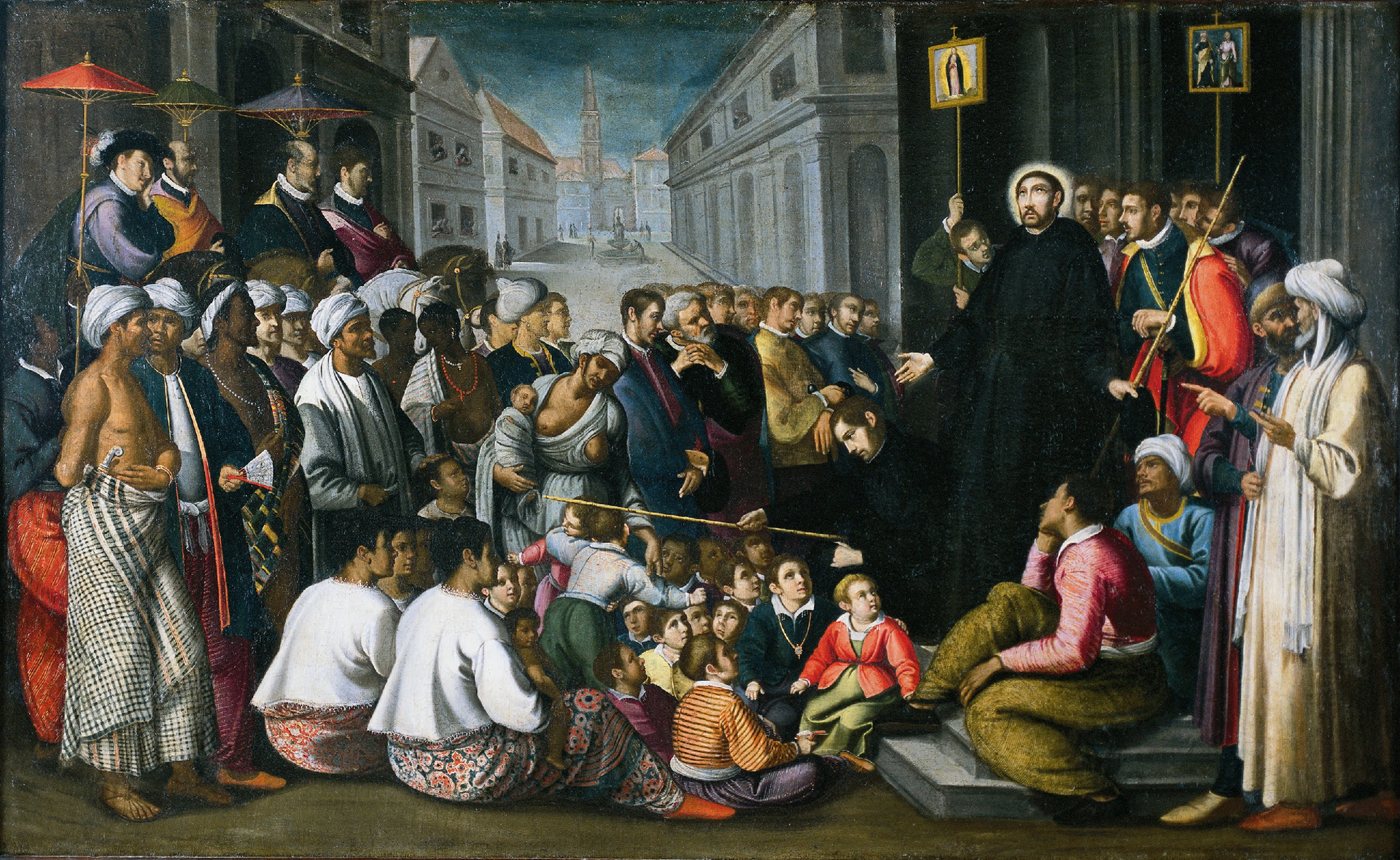 Saint Francis Xavier preaching in Goa (1610), by André Reinoso Francis Xavier left Lisbon on 7 April 1541, his thirty-fifth birthday, along with two other Jesuits and the new viceroy Martim Afonso de Sousa, on board the Santiago.[37] As he departed, Francis was given a brief from the pope appointing him apostolic nuncio to the East.[31] From August until March 1542 he remained in Portuguese Mozambique, and arrived in Goa, then capital of Portuguese India, on 6 May 1542, thirteen months after leaving Lisbon. The Portuguese, following quickly on the great voyages of discovery, had established themselves at Goa thirty years earlier. Francis's primary mission, as ordered by King John III, was to restore Christianity among the Portuguese settlers. According to Teotonio R. DeSouza, recent critical accounts indicate that apart from the posted civil servants, "the great majority of those who were dispatched as 'discoverers' were the riff-raff of Portuguese society, picked up from Portuguese jails."[38] Nor did the soldiers, sailors, or merchants come to do missionary work, and Imperial policy permitted the outflow of disaffected nobility. Many of the arrivals formed liaisons with local women and adopted Indian culture. Missionaries often wrote against the "scandalous and undisciplined" behaviour of their fellow Christians.[39] The Christian population had churches, clergy, and a bishop, but there were few preachers and no priests beyond the walls of Goa. Xavier decided that he must begin by instructing the Portuguese themselves, and gave much of his time to the teaching of children. The first five months he spent in preaching and ministering to the sick in the hospitals.[40] After that, he walked through the streets ringing a bell to summon the children and servants to catechism.[41] He was invited to head Saint Paul's College, a pioneer seminary for the education of secular priests, which became the first Jesuit headquarters in Asia.[42] Conversion efforts 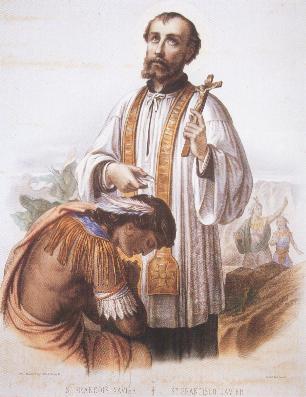 Conversion of the Paravars by Francis Xavier in South India, in a 19th-century coloured lithograph Xavier soon learned that along the Pearl Fishery Coast, which extends from Cape Comorin on the southern tip of India to the island of Mannar, off Ceylon (Sri Lanka), there was a Jāti of people called Paravas. Many of them had been baptised ten years before, merely to please the Portuguese who had helped them against the Moors, but remained uninstructed in the faith. Accompanied by several native clerics from the seminary at Goa, he set sail for Cape Comorin in October 1542. He taught those who had already been baptised and preached to those who weren't. His efforts with the high-caste Brahmins remained unavailing. The Brahmin and Muslim authorities in Travancore opposed Xavier with violence; time and again his hut was burned down over his head, and once he saved his life only by hiding among the branches of a large tree.[41] He devoted almost three years to the work of preaching to the people of southern India and Ceylon, converting many. He built nearly 40 churches along the coast, including St. Stephen's Church, Kombuthurai, mentioned in his letters dated 1544. During this time, he was able to visit the tomb of Thomas the Apostle in Mylapore (now part of Madras/Chennai then in Portuguese India).[31] He set his sights eastward in 1545 and planned a missionary journey to Makassar on the island of Celebes (today's Indonesia). As the first Jesuit in India, Francis had difficulty achieving much success in his missionary trips. His successors, such as de Nobili, Matteo Ricci, and Beschi, attempted to convert the noblemen first as a means to influence more people, while Francis had initially interacted most with the lower classes; (later though, in Japan, Francis changed tack by paying tribute to the Emperor and seeking an audience with him).[43]  Voyages of Saint Francis Xavier Southeast Asia 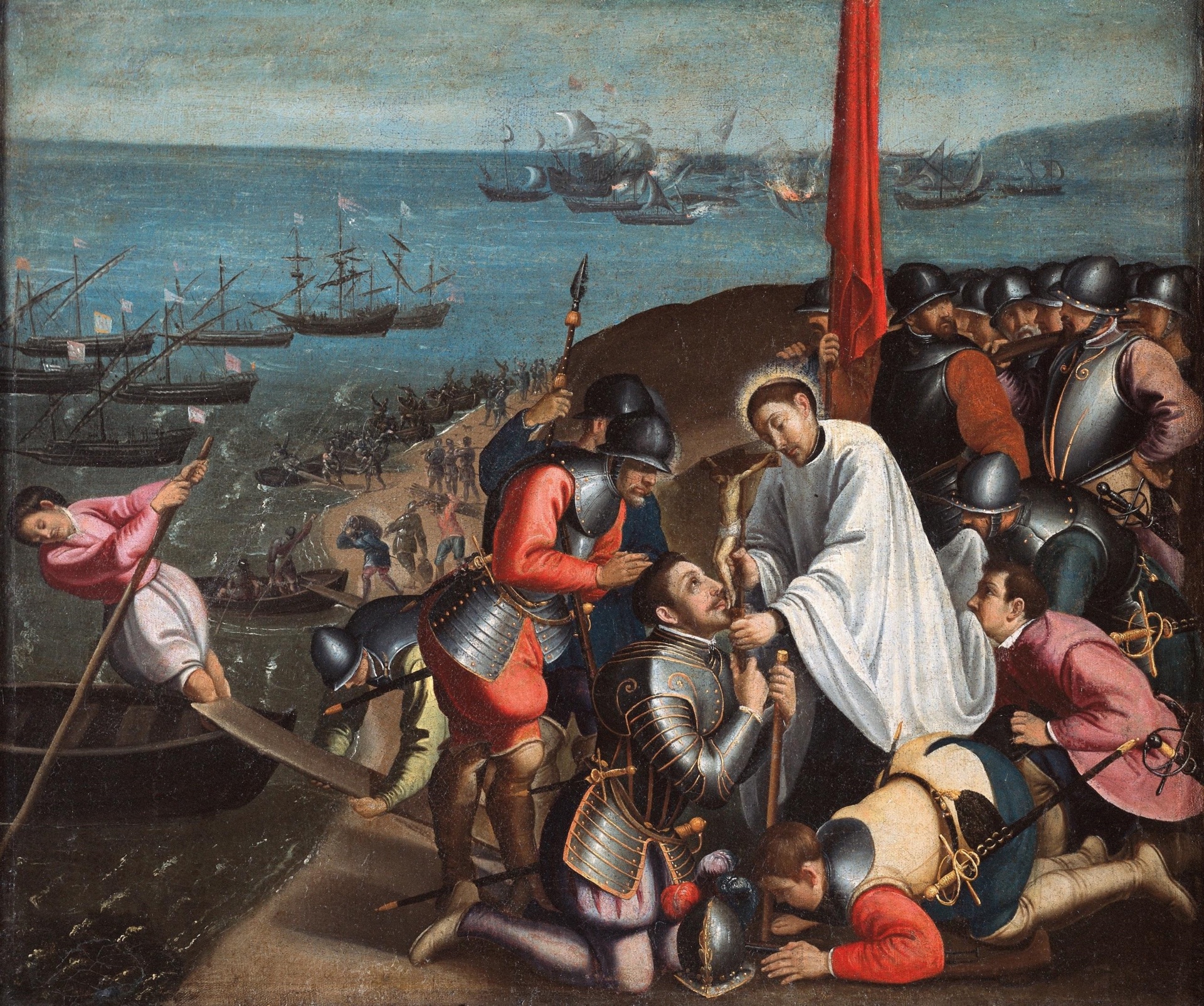 Saint Francis Xavier Inspiring Portuguese Troops Against the Acehnese Pirates by André Reinoso (1619) In the spring of 1545 Xavier started for Portuguese Malacca. He laboured there for the last months of that year. About January 1546, Xavier left Malacca for the Maluku Islands, where the Portuguese had some settlements. For a year and a half, he preached the Gospel there. He went first to Ambon Island, where he stayed until mid-June. He then visited the other Maluku Islands, including Ternate, Baranura, and Morotai.[40] Shortly after Easter 1547, he returned to Ambon Island; a few months later he returned to Malacca. While there, Malacca was attacked by the Acehnese from Sumatra, and through preaching Xavier inspired the Portuguese to seek battle, achieving a victory at the Battle of Perlis River, despite being heavily outnumbered.[44] Japan Main article: History of the Catholic Church in Japan  Virgin Mary with Infant Jesus and Her Fifteen Mysteries by an unknown Japanese artist (c. 1600). Bottom center: Ignatius of Loyola (left) and Francis Xavier (right) In Malacca in December 1547, Francis Xavier met a Japanese man named Anjirō.[40] Anjirō had heard of Francis in 1545 and had travelled from Kagoshima to Malacca to meet him. Having been charged with murder, Anjirō had fled Japan. He told Francis extensively about his former life, and the customs and culture of his homeland. Anjirō became the first Japanese Christian and adopted the name 'Paulo de Santa Fé'. He later helped Xavier as a mediator and interpreter for the mission to Japan that now seemed much more possible. In January 1548 Francis returned to Goa to attend to his responsibilities as superior of the mission there.[45] The next 15 months were occupied with various journeys and administrative measures. He left Goa on 15 April 1549, stopped at Malacca, and visited Canton. He was accompanied by Anjiro, two other Japanese men, Father Cosme de Torrès and Brother Juan Fernández. He had taken with him presents for the "King of Japan" since he was intending to introduce himself as the Apostolic Nuncio. Europeans had already come to Japan; the Portuguese had landed in 1543 on the island of Tanegashima, where they introduced matchlock firearms to Japan.[46] From Amboina, he wrote to his companions in Europe: "I asked a Portuguese merchant, ... who had been for many days in Anjirō's country of Japan, to give me ... some information on that land and its people from what he had seen and heard. ...All the Portuguese merchants coming from Japan tell me that if I go there I shall do great service for God our Lord, more than with the pagans of India, for they are a very reasonable people." (To His Companions Residing in Rome, From Cochin, 20 January 1548, no. 18, p. 178).[36] Francis Xavier reached Japan on 27 July 1549, with Anjiro and three other Jesuits, but he was not permitted to enter any port his ship arrived at until 15 August,[46] when he went ashore at Kagoshima, the principal port of Satsuma Province on the island of Kyūshū. As a representative of the Portuguese king, he was received in a friendly manner. Shimazu Takahisa (1514–1571), daimyō of Satsuma, gave a friendly reception to Francis on 29 September 1549, but in the following year he forbade the conversion of his subjects to Christianity under penalty of death; Christians in Kagoshima could not be given any catechism in the following years. The Portuguese missionary Pedro de Alcáçova would later write in 1554: In Cangoxima, the first place Father Master Francisco stopped at, there were a good number of Christians, although there was no one there to teach them; the shortage of labourers prevented the whole kingdom from becoming Christian. — Pacheco 1974, pp. 477–480 Francis was the first Jesuit to go to Japan as a missionary.[47] He brought with him paintings of the Madonna and the Madonna and Child. These paintings were used to help teach the Japanese about Christianity. There was a huge language barrier as Japanese was unlike other languages the missionaries had previously encountered. For a long time, Francis struggled to learn the language.[48] He was hosted by Anjirō's family until October 1550.[24] From October to December 1550, he resided in Yamaguchi. Shortly before Christmas, he left for Kyoto but failed to meet with the Emperor. He returned to Yamaguchi in March 1551, where the daimyo of the province gave him permission to preach. Having learned that evangelical poverty did not have the appeal in Japan that it had in Europe and in India, he decided to change his approach. Hearing after a time that a Portuguese ship had arrived at a port in the province of Bungo in Kyushu and that the prince there would like to see him, Xavier now set out southward. The Jesuit, in a fine cassock, surplice, and stole, was attended by thirty gentlemen and as many servants, all in their best clothes. Five of them bore on cushions valuable articles, including a portrait of Our Lady and a pair of velvet slippers, these not gifts for the prince, but solemn offerings to Xavier, to impress the onlookers with his eminence. Handsomely dressed, with his companions acting as attendants, he presented himself before Oshindono, the ruler of Nagate, and as a representative of the great kingdom of Portugal, offered him letters and presents: a musical instrument, a watch, and other attractive objects which had been given him by the authorities in India for the emperor.[41] For forty-five years the Jesuits were the only missionaries in Asia, but the Franciscans also began proselytising in Asia as well. Christian missionaries were later forced into exile, along with their assistants. However, some were able to stay behind. Christianity was then kept underground so as to not be persecuted.[49] The Japanese people were not easily converted; many of the people were already Buddhist or Shinto. Francis tried to combat the disposition of some of the Japanese that a God who had created everything, including evil, could not be good. Despite Francis's different religion, he felt that they were good people, much like Europeans, and could be converted.[50][51][52] Xavier was welcomed by the Shingon monks since he used the word Dainichi for the Christian God; attempting to adapt the concept to local traditions. As Xavier learned more about the religious nuances of the word, he changed to Deusu[24] from the Latin and Portuguese Deus. The monks later realised that Xavier was preaching a rival religion and grew more resistant towards his attempts at conversion.  The Altar of St. Francis Xavier Parish in Nasugbu, Batangas, Philippines. Saint Francis is the principal patron of the town, together with Our Lady of Escalera. With the passage of time, his sojourn in Japan could be considered somewhat fruitful as attested by congregations established in Hirado, Yamaguchi, and Bungo. Xavier worked for more than two years in Japan and saw his successor-Jesuits established. He then decided to return to India. Historians debate the exact path by which he returned, but from evidence attributed to the captain of his ship, he may have travelled through Tanegeshima and Minato, and avoided Kagoshima because of the hostility of the daimyo.[46] China During his trip from Japan back to India, a tempest forced him to stop on an island near Guangzhou, Guangdong, China, where he met Diogo Pereira, a rich merchant and an old friend from Cochin. Pereira showed him a letter from Portuguese prisoners in Guangzhou, asking for a Portuguese ambassador to speak to the Chinese Emperor on their behalf. Later during the voyage, he stopped at Malacca on 27 December 1551 and was back in Goa by January 1552.[citation needed] On 17 April he set sail with Diogo Pereira on the Santa Cruz for China. He planned to introduce himself as Apostolic Nuncio and Pereira as the ambassador of the King of Portugal. But then he realized that he had forgotten his testimonial letters as an Apostolic Nuncio. Back in Malacca, he was confronted by the captain Álvaro de Ataíde da Gama who now had total control over the harbour. The captain refused to recognize his title of Nuncio, asked Pereira to resign from his title of ambassador, named a new crew for the ship, and demanded the gifts for the Chinese Emperor be left in Malacca.[citation needed] In late August 1552, the Santa Cruz reached the Chinese island of Shangchuan, 14 km away from the southern coast of mainland China, near Taishan, Guangdong, 200 km south-west of what later became Hong Kong. At this time, he was accompanied only by a Jesuit student, Álvaro Ferreira, a Chinese man called António, and a Malabar servant called Christopher. Around mid-November, he sent a letter saying that a man had agreed to take him to the mainland in exchange for a large sum of money. Having sent back Álvaro Ferreira, he remained alone with António. He died from a fever at Shangchuan, Taishan, China, on 3 December 1552, while he was waiting for a boat that would take him to mainland China.[53] |
布教活動 パリ、サン=ピエール・ド・モンマルトル教会 1534年8月15日、パリを見下ろすモンマルトルの丘にあるサン・ドニ教会(現在のサン・ピエール・ド・モンマルトル)の地下聖堂に7人の学生が集まっ た。彼らはフランシスコ、ロヨラのイグナチオ、アルフォンソ・サルメロン、ディエゴ・ライネス、スペインのニコラス・ボバディラ、サヴォワのピーター・ フェイバー、ポルトガルのシマン・ロドリゲスであった。彼らは清貧、貞潔、教皇への服従を私的に誓い、また異教徒を改宗させるために聖地に行くことを誓っ た[25][26]。フランシスコは1534年に神学の勉強を始め、1537年6月24日に叙階された。 1539年、長い議論の末、イグナティウスは新しい修道会であるイエズス会(イエズス会)の公式を作成した[23]。イグナティウスの修道会の計画は 1540年に教皇パウロ3世によって承認された[27]。 1540年、ポルトガル国王ジョンは、ポルトガル大使ペドロ・マスカレンハスに、キリスト教の価値観がポルトガル人の間で失われつつあると国王が考えてい たインドの新しい領地で信仰を広めるためにイエズス会の宣教師を要請させた。パドロド協定の下、東インドへの宣教師派遣をローマ教皇に何度も要請した後、 ヨハネ3世はコレージュ・サント・バルブの学長ディオゴ・デ・グーヴェイアに勧められ、イエズス会を設立した新卒の学生たちを採用した[28]。  フランシスコ・ザビエル、遠征のためポルトガルのファン3世のもとを離れる, by José Avelar Rebelo イグナティウスはすぐにニコラス・ボバディラとシマン・ロドリゲスを任命した。しかし、最後の瞬間にボバディラが重い病気にかかった。イグナティウスは若 干のためらいと不安を感じながらも、ボバディラの代わりにフランシスコに遠征するよう要請した。こうして、フランシスコ・ザビエルは、ほとんど偶然に、最 初のイエズス会宣教師としての人生を歩み始めた[29][30][31]。 1540年3月15日、大使の列車でローマを出発したフランシスコは、ブレヴィアリー、カテキズム、そしてクロアチアの人文主義者マルコ・マルリッチの 『De Institutione bene vivendi』[33]を携行した。1549年にゴアから届いたF.バルタザール・ガゴの手紙によると、フランシスコが読んだり学んだりした唯一の書物 であったという[34]。フランシスコは1540年6月にリスボンに到着し、到着の4日後、ロドリゲスとともに国王と王妃の私的謁見に召された[35]。 フランシスコ・ザビエルはその生涯の大半をアジアでの宣教に捧げた: マラッカ、アンボイナとテルナテ(インドネシアのマルク諸島)、日本、中国沖合である。マラッカ、アンボイナ、テルナテ(インドネシアのマルク諸島)、日 本、そして中国沖合であった。中国はインドにいた頃から大きな存在だった。日本はその文化から特に魅力的だった。彼にとって、これらの地域は相互に関連し ており、別々に伝道することはできなかった[36]。 ゴアとインド  ゴアで説教する聖フランシスコ・ザビエル(1610年)、アンドレ・レイノソ作 フランシスコ・ザビエルは、1541年4月7日、彼の35歳の誕生日に、他の2人のイエズス会士と新総督マルティム・アフォンソ・デ・ソウザとともに、サ ンティアゴ号でリスボンを出発した[37]。出発の際、フランシスコはローマ教皇から東方使徒的宣教師に任命されるとの布告を受けた[31]。 ポルトガルは大航海の後を追うように、30年前にゴアに居を構えていた。ジョン3世から命じられたフランシスコの第一の使命は、ポルトガル人入植者たちに キリスト教を復活させることだった。テオトニオ・R・デスーザによれば、最近の批評によれば、赴任してきた公務員を除けば、「『発見者』として派遣された 人々の大多数は、ポルトガルの刑務所から拾われたポルトガル社会の有象無象であった」[38]。到着した人々の多くは、現地の女性と関係を結び、インディ アンの文化を取り入れた。宣教師たちはしばしば、同胞であるキリスト教徒の「スキャンダラスで規律に欠ける」振る舞いに対して反感を書いた[39]。 キリスト教徒は教会や聖職者を持ち、司教もいたが、伝道者は少なく、ゴアの城壁の外には司祭もいなかった。ザビエルは、まずポルトガル人自身を指導するこ とから始めなければならないと考え、多くの時間を子供たちの教育に費やした。最初の5ヶ月間は、説教と病院での病人への奉仕に費やした[40]。その後、 鈴を鳴らして通りを歩き、子供たちや召使たちをカテキズムに呼び出した[41]。アジアで最初のイエズス会本部となった、世俗司祭教育のための先駆的な神 学校であるセント・ポール・カレッジの校長に招かれた[42]。 改宗の努力  南インドにおけるフランシスコ・ザビエルによるパラヴァール人の改宗(19世紀のカラーリトグラフ)。 ザビエルはすぐに、インド南端のコモリン岬からセイロン(スリランカ)沖のマンナール島まで続く真珠漁海岸沿いに、パラヴァと呼ばれるジャーティ族がいる ことを知った。彼らの多くは10年前に洗礼を受けたが、それは単にムーア人と戦って助けてくれたポルトガル人を喜ばせるためであり、信仰については何も教 えられていないままだった。1542年10月、ゴアの神学校から数人のネイティブの聖職者を伴って、彼はコモリン岬に向けて出航した。すでに洗礼を受けて いる人々には教え、そうでない人々には説教した。カーストの高いバラモン教徒に対する彼の努力は実を結ばなかった。トラバンコールのバラモン教徒とイスラ ム教徒の権力者たちはザビエルに暴力で対抗し、彼の小屋は何度も何度も頭上から焼き払われ、一度は大木の枝の間に隠れて命拾いをしたこともあった [41]。 ザビエルは、南インドとセイロンの人々への説教に3年近くを費やし、多くの人々を改宗させた。1544年付けの書簡に記されているコンブトゥライの聖ステ ファノ教会をはじめ、海岸沿いに40近くの教会を建てた。 この間、マイラポール(現在のマドラス/チェンナイの一部、当時のポルトガル領インド)にある使徒トマスの墓を訪れることができた[31]。1545年、 彼は東方に目標を定め、セレベス島(現在のインドネシア)のマカッサルへの布教旅行を計画した。 インドで最初のイエズス会士であったフランシスコは、布教の旅で大きな成功を収めることは難しかった。デ・ノビリ、マテオ・リッチ、ベスキなどの後継者た ちは、より多くの人々に影響を与える手段として、まず貴族を改宗させようとしたが、フランシスコは当初、下層階級と最も交流があった。(しかしその後、フ ランシスコは日本で、天皇に朝貢し、天皇に謁見することで方針を変えた)[43]。  聖フランシスコ・ザビエルの航海 東南アジア  アチェの海賊と戦うポルトガル軍を鼓舞する聖フランシスコ・ザビエル。André Reinoso 作 1545年の春、ザビエルはポルトガルのマラッカに向けて出発した。彼はその年の最後の数ヶ月間、そこで労働した。1546年1月、ザビエルはマラッカを 離れ、ポルトガルの入植地であったマルク諸島に向かった。そこで1年半にわたって福音を宣教した。まずアンボン島に行き、6月中旬まで滞在した。その後、 テルナテ島、バラヌラ島、モロタイ島など他のマルク諸島を訪れた[40]。1547年の復活祭の直後にアンボン島に戻り、数ヵ月後にマラッカに戻った。そ の間にマラッカはスマトラからのアチェ人の襲撃を受け、ザビエルは説教を通してポルトガル人に戦いを挑むよう鼓舞し、多勢に無勢であったにもかかわらず、 ペルリス川の戦いで勝利を収めた[44]。 日本 主な記事 日本のカトリック教会の歴史  聖母マリアと幼子イエスと十五の秘儀」作者不詳(1600年頃)。中央下: ロヨラのイグナチオ(左)とフランシスコ・ザビエル(右)——京都大学博物館蔵(?) 1545年にフランシスコの噂を聞いた安次郎は、フランシスコに会うために鹿児島からマラッカに向かった。安次郎は殺人罪で起訴され、日本から逃亡してい た。安次郎はフランシスコに、かつての生活や故郷の習慣や文化について広く語った。安次郎は日本人初のキリスト教徒となり、「パウロ・デ・サンタ・フェ」 と名乗った。その後、安次郎は日本宣教の仲介者、通訳としてザビエルに協力した。 1548年1月、フランシスコはゴア宣教会の責任者としてゴアに戻った[45]。その後15ヶ月間は、さまざまな旅と管理運営に追われた。1549年4月 15日、ゴアを出発し、マラッカに立ち寄り、広東を訪れた。アンジロー、2人の日本人、コスメ・デ・トレス神父、フアン・フェルナンデス兄弟が同行した。 使徒的ヌンシオであることを紹介するため、「日本国王」への贈り物を持参していた。 ポルトガル人は1543年に種子島に上陸し、日本にマッチロック式火器を伝えた[46]。 安次郎の国日本に何日も滞在していたポルトガル商人に、彼が見聞きしたその土地と人々に関する情報を教えてくれるよう頼んだ。...日本から来るポルトガ ル商人たちは皆、もし私がそこに行けば、インドの異教徒たちよりも、私たちの主である神のために大いなる奉仕をすることになるだろうと言っています。 (ローマ在住の仲間たちへ、コーチンより、1548年1月20日、18号、178頁)[36]。 フランシスコ・ザビエルは1549年7月27日、安次郎と他の3人のイエズス会士とともに日本に到着したが、8月15日に九州の薩摩国の主要港である鹿児 島に上陸するまで、船が到着したどの港にも入ることは許されなかった[46]。ポルトガル国王の代理として、彼は友好的に迎えられた。薩摩の大名であった 島津貴久(1514-1571)は、1549年9月29日にフランシスコを友好的に迎えたが、翌年には死刑を科して臣下のキリスト教への改宗を禁じた。ポ ルトガルの宣教師ペドロ・デ・アルカソヴァは、後に1554年にこう記している: フランシスコ神父が最初に立ち寄ったカンゴキシマでは、かなりの数のキリシタンがいたが、彼らを教える者はいなかった。 - パチェコ1974、477-480頁 フランシスコは、宣教師として日本に行った最初のイエズス会士であった[47]。これらの絵は、日本人にキリスト教を教えるために使われた。日本語は宣教 師たちがそれまでに出会った他の言語とは異なっていたため、大きな言葉の壁があった。長い間、フランシスコは日本語を学ぶのに苦労した[48]。1550 年10月までは安次郎の家族のもてなしを受け、10月から12月までは山口に滞在した[24]。クリスマスの少し前に京都に向かったが、天皇に会うことは できなかった。1551年3月に山口に戻り、諸大名から説教の許可を得た。 日本では、ヨーロッパやインドで行われていたような福音的清貧の魅力がないことを知った彼は、アプローチを変えることにした。しばらくして、ポルトガルの 船が九州の豊後国の港に到着し、そこの王子がザビエルに会いたがっていることを聞いたザビエルは、今度は南に向かって出発した。イエズス会士は、上等なカ ソックとスルプリスとストールを身につけ、30人の紳士と同じ数の召使に付き添われた。そのうちの5人は、聖母の肖像画やビロードのスリッパなど、貴重な 品々を座布団の上に載せていたが、これらは王子への贈り物ではなく、ザビエルへの厳粛な捧げ物であり、見物人に彼の高貴さを印象づけるためのものであっ た。ハンサムに着飾ったザビエルは、仲間を従者として従え、長手の統治者オシンドノの前に姿を現し、偉大なポルトガル王国の代表として、皇帝のためにイン ドの当局から贈られた楽器、時計、その他の魅力的な品々といった手紙や贈り物を差し出した[41]。 45年間、イエズス会はアジアで唯一の宣教師であったが、フランシスコ会もアジアで布教を始めた。その後、キリスト教宣教師たちは助手たちとともに亡命を 余儀なくされた。しかし、何人かは残ることができた。その後、キリスト教は迫害されないように地下に潜るようになった[49]。 日本人の多くはすでに仏教徒か神道徒であった。フランシスコは、悪を含めてすべてを創造した神が善であるはずがないという一部の日本人の気質と闘おうとし た。フランシスコは、宗教が異なるにもかかわらず、彼らはヨーロッパ人と同じように善良な人々であり、改宗させることができると感じた[50][51] [52]。 ザビエルは、キリスト教の神に対して大日という言葉を使い、その概念を 現地の伝統に適応させようとしたため、真言宗の僧侶たちに歓迎された。ザビエルはこの言葉の宗教的なニュアンスについて学ぶにつれ、ラテン語とポルトガル 語のDeusからDeusu[24]に変更した。修道士たちは後に、ザビエルが対立する宗教を説いていることに気づき、改宗を試みるザビエルに対して抵抗 を強めていった。  フィリピン、バタンガス州ナスグブの 聖フランシスコ・ザビエル教区の祭壇。聖フランシスコは、エスカレラの聖母とともにこの町の主要な守護者である。 時の流れとともに、ザビエルの日本滞在は、平戸、山口、豊後に設立された信徒が証明するように、いくぶん実り多いものとなった。ザビエルは日本で2年以上 働き、後継のイエズス会が設立されるのを見た。その後、彼はインドに戻ることを決意した。歴史家たちは、ザビエルがどのような経路で帰国したのかについて 議論しているが、ザビエルの船の船長によると、ザビエルは種子島と湊を経由し、大名の敵意のために鹿児島を避けたと考えられている[46]。 中国 日本からインドに戻る旅の途中、大嵐のため中国広東省広州市近くの島に立ち寄った際、コーチンからの旧友で裕福な商人ディオゴ・ペレイラに出会った。ペレ イラは、広州のポルトガル人囚人たちからの手紙を見せ、彼らに代わって中国皇帝に話すポルトガル大使を要請した。その後、航海中の1551年12月27日 にマラッカに立ち寄り、1552年1月までにゴアに戻った[要出典]。 4月17日、ディオゴ・ペレイラとともにサンタ・クルス号で中国に向けて出航。彼は、自分が使徒的ヌンシオであり、ペレイラがポルトガル国王の大使である ことを紹介するつもりであった。しかしその時、使徒的ヌンシオとしての証文を忘れたことに気づいた。マラッカに戻った彼は、今や港を完全に支配している船 長アルバロ・デ・アタイデ・ダ・ガマに直面した。船長は彼のヌンシオの称号を認めず、ペレイラに大使の辞職を求め、船の新しい乗組員を指名し、中国皇帝へ の贈り物をマラッカに残すよう要求した[要出典]。 1552年8月下旬、サンタ・クルス号は中国本土の南海岸から14km離れた、後の香港の南西200kmに位置する広東省泰山の近くにある中国の島、上川 に到着した。この時、彼が同行していたのは、イエズス会の学生アルバロ・フェレイラ、アントニオと呼ばれる中国人、クリストファーと呼ばれるマラバルの使 用人のみであった。11月中旬頃、彼はある男が大金と引き換えに自分を大陸に連れて行くことに同意したという手紙を送った。アルバロ・フェレイラを送り返 し、アントニオと二人きりになった。1552年12月3日、中国本土へ向かう船を待っている間に、中国泰山の上川で熱病により死去した[53]。 |
Burials and relics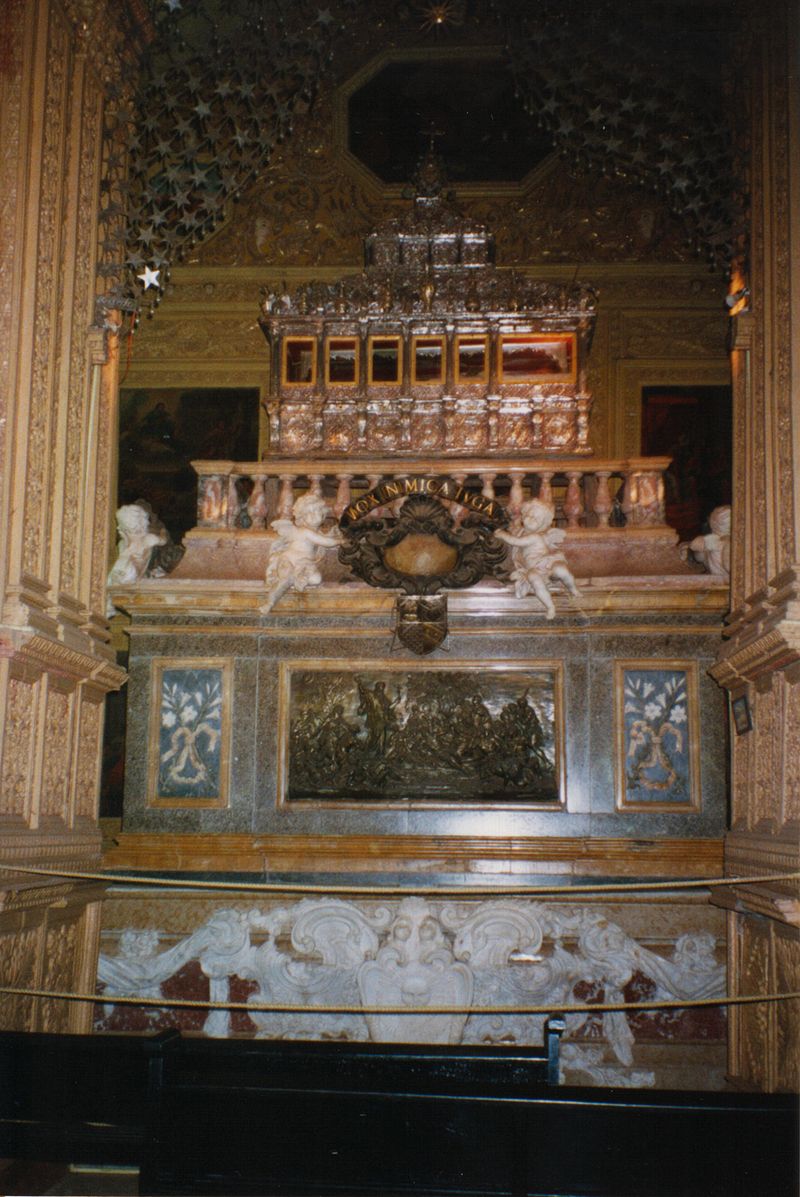 Casket of Saint Francis Xavier in the Basilica of Bom Jesus in Goa, India Xavier was first buried on a beach at Shangchuan Island, Taishan, Guangdong. His body was taken from the island in February 1553 and temporarily buried in St. Paul's Church in Portuguese Malacca on 22 March 1553. An open grave in the church now marks the place of Xavier's burial. Pereira came back from Goa, removed the corpse shortly after 15 April 1553, and moved it to his house. On 11 December 1553, Xavier's body was shipped to Goa.[54] The mostly-incorruptible body[55] is now in the Basilica of Bom Jesus in Goa, where it was placed in a glass container encased in a silver casket on 2 December 1637.[56] This casket, constructed by Goan silversmiths between 1636 and 1637, was an exemplary blend of Italian and Indian aesthetic sensibilities. There are 32 silver plates on all four sides of the casket, depicting different episodes from the life of Xavier: Francis lies on the ground with his arms and legs tied, but the cords break miraculously. Francis kisses the ulcer of a patient in a Venetian hospital. He is visited by Jerom as he lies ailing in the hospital of Vicenza. A vision about his future apostolate. A vision about his sister's prophecy about his fate. He saves the secretary of the Portuguese Ambassador while crossing the Alps. He lifts a sick man who dies after receiving communion but is freed from fever. He baptises in Travancore. He resuscitates a boy who died in a well at Cape Comorin. He cures miraculously a man full of sores. He drives away the Badagas in Travancore. He resuscitates three persons: a man who was buried at Coulao; a boy about to be buried at Multao; and a child. He takes money from his empty pockets and gives it to a Portuguese at Malyapore. A miraculous cure. A crab restores his crucifix which had fallen into the sea. He preaches in the island of Moro. He preaches in the sea of Malacca and announces the victory against the enemies. He converts a Portuguese soldier. He helps the dying Vicar of Malacca. Francis kneels down and on his shoulders there rests a child whom he restores to health. He goes from Amanguchi to Macao walking. He cures a mute or unable to speak and paralytic man in Amanguchi. He cures a deaf Japanese person. He prays in the ship during a storm. He baptises three kings in Cochin. He cures a religious in the college of St. Paul. Due to the lack of water, he sweetens the seawater during a voyage. The agony of Francis at Sancian. After his death, he is seen by a lady according to his promise. The body dressed in sacerdotal vestments is exposed for public veneration. Francis levitates as he distributes communion in the College of St. Paul. The body is placed in a niche at Chaul with lighted candles. On the top of this casket, there is a cross with two angels. One is holding a burning heart and the other a legend which says, "Satis est Domine, satis est." (It's enough Lord, it's enough) The right forearm, which Xavier used to bless and baptise his converts, was detached by Superior General Claudio Acquaviva in 1614. It has been displayed since in a silver reliquary at the main Jesuit church in Rome, Il Gesù.[57] 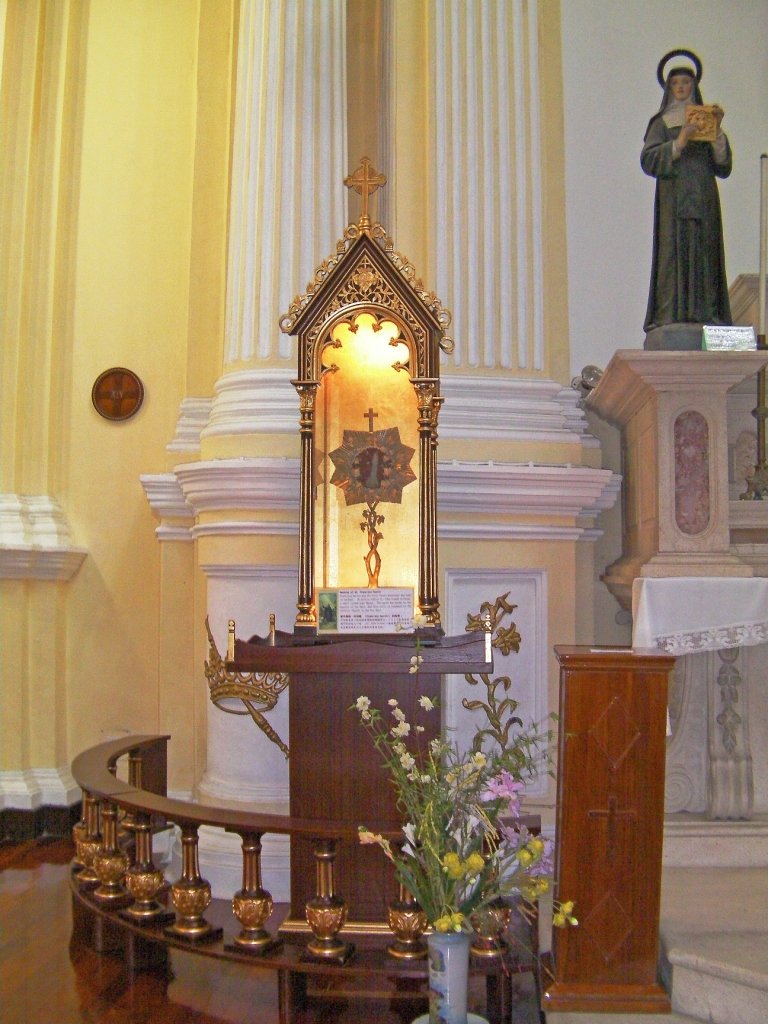 Saint Francis Xavier's humerus at St. Joseph's Church, Macao (2008) Another of Xavier's arm bones was brought to Macau where it was kept in a silver reliquary. The relic was destined for Japan but religious persecution there persuaded the church to keep it in Macau's Cathedral of St. Paul. It was subsequently moved to St. Joseph's and in 1978 to the Chapel of St. Francis Xavier on Coloane Island. More recently the relic was moved to St. Joseph's Church.[58] A relict from the right hand of St Francis Xavier is on display at St Mary's Cathedral, Sydney. In 2006, on the 500th anniversary of his birth, the Xavier Tomb Monument and Chapel on Shangchuan Island, in ruins after years of neglect under communist rule in China, was restored with support from the alumni of Wah Yan College, a Jesuit high school in Hong Kong.[citation needed] From December 2017 to February 2018, Catholic Christian Outreach (CCO) in cooperation with the Jesuits, and the Archdiocese of Ottawa (Canada) brought Xavier's right forearm to tour throughout Canada. The faithful, especially university students participating with CCO at Rise Up 2017 in Ottawa, venerated the relics. The tour continued to every city where CCO and/or the Jesuits are present in Canada: Quebec City, St. John's, Halifax, St. Francis Xavier University in Antigonish (neither CCO nor the Jesuits are present here), Kingston, Toronto, Winnipeg, Saskatoon, Regina, Calgary, Vancouver, Victoria, and Montreal before returning to Ottawa.[59] The relic was then returned to Rome with a Mass of Thanksgiving celebrated by Archbishop Terrence Prendergast at the Church of the Gesu.[citation needed] |
埋葬と聖遺物 インド、ゴアのボム・ジーザス聖堂にある聖フランシスコ・ザビエルの棺 ザビエルが最初に埋葬されたのは、広東省泰山市上川島の浜辺であった。彼の遺体は1553年2月に島から運び出され、3月22日にポルトガル領マラッカの セント・ポール教会に仮埋葬された。現在、教会にはザビエルが埋葬された場所を示す公開墓がある。ペレイラはゴアから戻り、1553年4月15日過ぎに死 体を運び出し、自分の家に移した。1553年12月11日、ザビエルの遺体はゴアに運ばれた[54]。 1637年12月2日、銀の棺に包まれたガラスの容器に納められた。この棺は、1636年から1637年にかけてゴアの銀細工職人によって作られたもの で、イタリアとインドの美的感覚が見事に融合した模範的なものであった。棺の四面には32枚の銀板があり、ザビエルの生涯のさまざまなエピソードが描かれ ている: フランシスコは手足を縛られて地面に横たわっているが、紐は奇跡的に切れる。 ヴェネツィアの病院で患者の潰瘍にキスをするフランシスコ。 ヴィチェンツァの病院で病床のフランシスコをジェロムが見舞う。 将来の使徒職についての幻視。 自分の運命についての姉の予言についてのビジョン。 アルプス越えの途中、ポルトガル大使の秘書を助ける。 聖体拝領後に死亡した病人を助けるが、熱病から解放される。 トラバンコールで洗礼を授ける。 コモリン岬の井戸で死んだ少年を蘇生させる。 腫れ物だらけの男を奇跡的に治した。 トラバンコールでバダガを追い払う。 クーラオで埋葬されていた男、ムルタオで埋葬されようとしていた少年、そして子供。 空っぽのポケットからお金を取り出し、マルヤポールのポルトガル人に渡す。 奇跡的な治療。 海に落ちた十字架をカニが修復。 モロ島で説教。 マラッカの海で説教し、敵に勝利を告げる。 ポルトガル兵を改宗させる。 瀕死のマラッカ司教を助ける。 フランシスコはひざまずき、その肩の上に子供を寝かせ、健康を回復させる。 アマンギからマカオまで歩いて行く。 フランシスコはアマンギで口がきけず、麻痺している人を治す。 耳の聞こえない日本人を治す。 嵐の中、船の中で祈る。 コーチンで3人の王に洗礼を授ける。 聖パウロ大学で修道者を癒す。 水不足のため、航海中に海水を甘くする。 サンシアンでのフランシスコの苦悩。 死後、フランシスコは約束通り、ある女性に見初められる。 聖職者の法衣に身を包んだ遺体は、一般の人々の崇敬のために晒される。 聖パウロ大学で聖体拝領をするフランシスコ。 遺体はチャウルの龕(がん)に納められ、ろうそくに火が灯される。この棺の上部には、2人の天使が描かれた十字架がある。一人は燃える心臓を持ち、もう一 人は "Satis est Domine, satis est."(主よ、もう十分です。(主よ、もう十分です)。 ザビエルが改宗者を祝福し、洗礼を授けるために使用していた右腕は、1614年に総長クラウディオ・アッカヴィーヴァによって切り離された。それ以来、 ローマのイエズス会の主要教会であるイル・ジェズーの銀の聖遺物箱の中に展示されている[57]。  マカオの聖ヨセフ教会にある聖フランシスコ・ザビエルの上腕骨(2008年) ザビエルのもう一つの腕骨はマカオに運ばれ、銀の聖遺物箱に入れられて保管された。聖遺物は日本に送られる予定だったが、日本での宗教迫害のため、教会は マカオの聖ポール天主堂に保管するよう説得した。その後、聖ヨセフ聖堂に移され、1978年にはコロアン島の聖フランシスコ・ザビエル礼拝堂に移された。 さらに最近、聖遺物は聖ヨセフ教会に移された[58]。 聖フランシスコ・ザビエルの右手の聖遺物はシドニーのセント・メアリー大聖堂に展示されている。 2006年、ザビエル生誕500周年を機に、中国の共産主義支配下で長年放置され廃墟と化していた上川島のザビエル墳墓記念碑と礼拝堂が、香港のイエズス 会系高校であるワーヤン・カレッジの卒業生の支援により修復された[要出典]。 2017年12月から2018年2月にかけて、カトリック・クリスチャン・アウトリーチ(CCO)はイエズス会と協力し、オタワ大司教区(カナダ)がザビ エルの右前腕をカナダ全土に巡回させた。オタワで開催されたライズアップ2017にCCOとともに参加した大学生を中心に、信者たちが聖遺物を崇敬した。 ツアーは、CCOおよび/またはイエズス会がカナダに存在するすべての都市で続けられた: ケベック・シティ、セント・ジョンズ、ハリファックス、アンティゴニッシュのセント・フランシス・ザビエル大学(ここにはCCOもイエズス会も存在しな い)、キングストン、トロント、ウィニペグ、サスカトゥーン、レジーナ、カルガリー、バンクーバー、ビクトリア、モントリオールを巡り、オタワに戻った [59]。その後、聖遺物はローマに戻され、ゲス教会でテレンス・プレンダーガスト大司教によって感謝のミサが執り行われた[要出典]。 |
| Veneration Beatification and canonization Francis Xavier was beatified by Paul V on 25 October 1619, and was canonized by Gregory XV on 12 March[60] 1622, at the same time as Ignatius Loyola.[61] Pius XI proclaimed him the "Patron of Catholic Missions".[62] His feast day is 3 December.[63] Pilgrimage centres Goa  Goan Catholics celebrating the feast of Saint Francis Xavier at Bom Jesus Basilica Saint Francis Xavier's relics are kept in a silver casket, elevated inside the Bom Jesus Basilica and are exposed (being brought to ground level) generally every ten years, but this is discretionary. The sacred relics went on display starting on 22 November 2014 at the XVII Solemn Exposition. The display closed on 4 January 2015.[64] The previous exposition, the sixteenth, was held from 21 November 2004 to 2 January 2005.[65] Relics of Saint Francis Xavier are also found in the Espirito Santo (Holy Spirit) Church, Margão,[66] in Sanv Fransiku Xavierachi Igorz (Church of St. Francis Xavier), Batpal, Canacona, Goa,[67] and at St. Francis Xavier Chapel, Portais, Panjim.[68] Other places Other pilgrimage centres include Xavier's birthplace in Navarra;[69] the Church of the Gesù, Rome;[70] Malacca (where he was buried for two years, before being brought to Goa);[71] and Sancian (place of death).[72] Xavier is a major venerated saint in both Sonora and the neighbouring U.S. state of Arizona. In Magdalena de Kino in Sonora, Mexico, in the Church of Santa María Magdalena, there is a reclining statue of San Francisco Xavier brought by pioneer Jesuit missionary Padre Eusebio Kino in the early 18th century. The statue is said to be miraculous and is the object of pilgrimage for many in the region.[73] Also the Mission San Xavier del Bac is a pilgrimage site.[74] The mission is an active parish church ministering to the people of the San Xavier District, Tohono O'odham Nation, and nearby Tucson, Arizona. Francis Xavier is honored in the Church of England and in the Episcopal Church on 3 December.[75][76] Novena of Grace Further information: Novena of Grace The Novena of Grace is a popular devotion to Francis Xavier, typically prayed either on the nine days before 3 December, or on 4 March through 12 March (the anniversary of Pope Gregory XV's canonisation of Xavier in 1622). It began with the Italian Jesuit missionary Marcello Mastrilli. Before he could travel to the Far East, Mastrilli was gravely injured in a freak accident after a festive celebration dedicated to the Immaculate Conception in Naples. Delirious and on the verge of death, Mastrilli saw Xavier, who he later said asked him to choose between travelling or death by holding the respective symbols, to which Mastrilli answered, "I choose that which God wills."[77] Upon regaining his health, Mastrilli made his way via Goa and the Philippines to Satsuma, Japan. The Tokugawa shogunate beheaded the missionary in October 1637, after undergoing three days of tortures involving the volcanic sulphurous fumes from Mt. Unzen, known as the Hell mouth or "pit" that had supposedly caused an earlier missionary to renounce his faith.[78] |
崇敬 列福と列聖 フランシスコ・ザビエルは1619年10月25日にパウロ5世によって列福され、1622年3月12日にグレゴリウス15世によって列聖された[60]。 巡礼地 ゴア  ボム・ジーザス・バシリカで聖フランシスコ・ザビエルの祝日を祝うゴアのカトリック信者たち 聖フランシスコ・ザビエルの聖遺物は銀の棺に収められ、ボム・ジーザス・バシリカ内に安置されている。聖遺物は2014年11月22日から第17回荘厳博 覧会で公開された。展示は2015年1月4日に終了した[64]。前回の第16回博覧会は2004年11月21日から2005年1月2日まで開催された [65]。 聖フランシスコ・ザビエルの聖遺物は、マルガオのエスピリト・サント(聖霊)教会[66]、ゴア州カナコナのバトパルにあるサンヴ・フランシク・ザビエル 教会(聖フランシスコ・ザビエル教会)[67]、パンジムのポルタイスにある聖フランシスコ・ザビエル礼拝堂にもある[68]。 その他の場所 その他の巡礼地としては、ナヴァラのザビエルの生誕地[69]、ローマのゲス教会[70]、マラッカ(ゴアに運ばれるまでの2年間、ザビエルが埋葬された 場所)[71]、サンシアン(没した場所)[72]などがある。 ザビエルは、ソノラ州と隣接するアメリカ・アリゾナ州の両方で崇敬されている主要な聖人である。メキシコのソノラ州マグダレナ・デ・キノのサンタ・マリ ア・マグダレナ教会には、18世紀初頭にイエズス会の宣教師エウセビオ・キノ神父が持ち込んだサン・フランシスコ・ザビエルの涅槃像がある。この像は奇跡 の像と言われ、この地域の多くの人々が巡礼の対象としている[73]。また、サン・サビエル・デル・バック伝道所も巡礼地である[74]。この伝道所は、 サン・サビエル地区、トホノ・オダム族、アリゾナ州ツーソン近郊の人々に奉仕する活発な教区教会である。 フランシスコ・ザビエルは英国国教会とエピスコパル教会で12月3日に祭られている[75][76]。 恩寵のノヴェナ さらなる情報 恩寵のノヴェナ ノヴェナ・オブ・グレイスは、フランシスコ・ザビエルへの一般的な信心であり、一般的には12月3日以前の9日間、または3月4日から3月12日 (1622年に教皇グレゴリウス15世がザビエルの列聖を行った記念日)に祈られる。その始まりは、イタリアのイエズス会宣教師マルチェロ・マストリッリ である。極東への旅を前に、マストリリはナポリで無原罪の聖母に捧げる祝祭の後、不慮の事故で重傷を負った。マストリッリは、錯乱して死の淵に立たされた ザビエルに会い、ザビエルは後に、それぞれのシンボルを持って旅か死かどちらかを選ぶよう求めたと語った。徳川幕府は1637年10月、以前の宣教師が信 仰を捨てる原因となったとされる地獄口または「落とし穴」として知られる雲仙岳の火山性亜硫酸ガスによる3日間の拷問を受けた後、宣教師の首をはねた [78]。 |
Legacy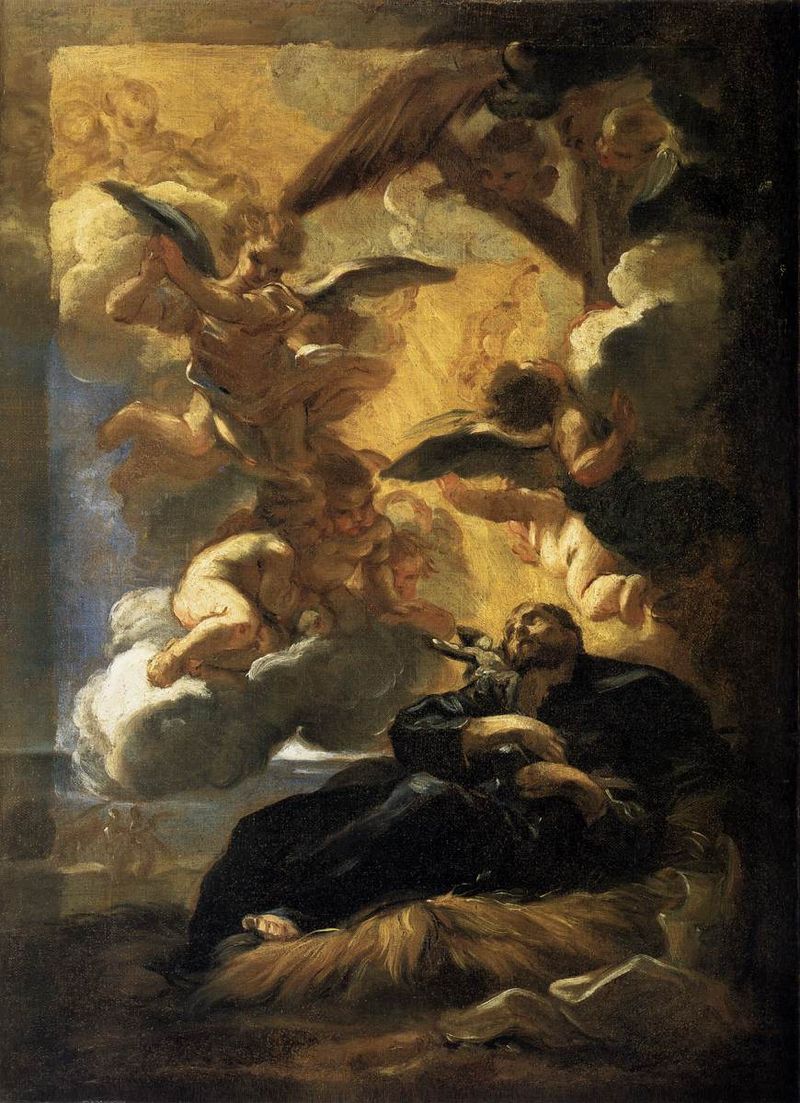 The Vision of St. Francis Xavier, by Giovanni Battista Gaulli Francis Xavier became widely noteworthy for his missionary work, both as an organiser and as a pioneer; he reputedly converted more people than anyone else had done since Paul the Apostle. In 2006 Pope Benedict XVI said of both Ignatius of Loyola and Francis Xavier: "not only their history which was interwoven for many years from Paris and Rome, but a unique desire – a unique passion, it could be said – moved and sustained them through different human events: the passion to give to God-Trinity a glory always greater and to work for the proclamation of the Gospel of Christ to the peoples who had been ignored."[62] His personal efforts most affected religious practice in India and in the East Indies (Indonesia, Malaysia, Timor). As of 2021 India still has numerous Jesuit missions and many more schools. Xavier also worked to propagate Christianity in China and Japan. However, following the persecutions (1587 onwards) instituted by Toyotomi Hideyoshi and the subsequent closing of Japan to foreigners (1633 onwards), the Christians of Japan had to go underground to preserve an independent Christian culture.[79] Likewise, while Xavier inspired many missionaries to China, Chinese Christians also were forced underground there and developed their own Christian culture. A small chapel designed by Achille-Antoine Hermitte was completed in 1869 over Xavier's death-place on Shangchuan Island, Canton. It was damaged and restored several times; the most recent restoration in 2006 marked the 500th anniversary of the saint's birth.[80] Francis Xavier is the patron saint of his native Navarre, which celebrates his feast day on 3 December as a government holiday.[81] In addition to Roman Catholic Masses remembering Xavier on that day (now known as the Day of Navarra), celebrations in the surrounding weeks honour the region's cultural heritage. Furthermore, in the 1940s, devoted Catholics instituted the Javierada, an annual day-long pilgrimage (often on foot) from the capital at Pamplona to Xavier, where the Jesuits built a basilica and museum and restored Francis Xavier's family's castle.[69] Personal names Statue of Santo Fransiskus Xaverius, at Jesuit Gereja Katedral Santa Perawan Maria Diangkat Ke Surga, in Jakarta, Indonesia Statue of Saint Francis Xavier, at St. Francis Xavier Catholic Church, in Superior, Wisconsin, United States 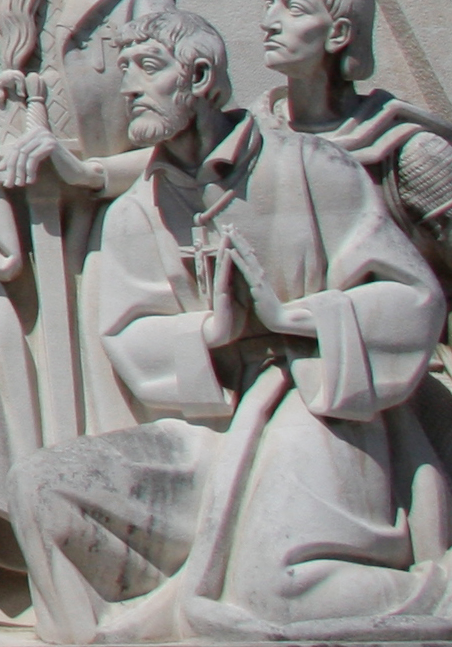 Effigy of Saint Francis Xavier in the Monument to the Discoveries in Lisbon, Portugal As the foremost saint from Navarre and one of the main Jesuit saints, Francis Xavier is much venerated in Spain and the Hispanic countries where Francisco Javier or Javier are common male given names.[82] The alternative spelling Xavier is also popular in the Basque Country, Portugal, Catalonia, Brazil, France, Belgium, and southern Italy. In India, the spelling Xavier is almost always used, and the name is quite common among Christians, especially in Goa and in the southern states of Tamil Nadu, Kerala, and Karnataka. The names Francisco Xavier, António Xavier, João Xavier, Caetano Xavier, Domingos Xavier and so forth, were very common till quite recently in Goa. Fransiskus Xaverius is commonly used as a name for Indonesian Catholics, usually abbreviated as FX. In Austria and Bavaria the name is spelt as Xaver (pronounced /ˈksaːfɐ/) and often used in addition to Francis as Franz-Xaver (/frant͡sˈksaːfɐ/). In Polish the name becomes Ksawery. Many Catalan men are named for him, often using the two-name combination Francesc Xavier. In English-speaking countries, "Xavier" until recently was likely to follow "Francis"; in the 2000s, however, "Xavier" by itself became more popular than "Francis", and after 2001 featured as one of the hundred most common male baby names in the US.[83] Furthermore, the Sevier family name, possibly most famous in the United States for John Sevier (1745–1815), originated from the name "Xavier".[84] Church dedications Many churches all over the world, often founded by Jesuits, have been named in honour of Xavier. The many in the United States include the historic St. Francis Xavier Shrine at Warwick, Maryland (founded 1720), and the Basilica of St. Francis Xavier in Dyersville, Iowa. Note also the American educational teaching order, the Xaverian Brothers, and the Mission San Xavier del Bac in Tucson, Arizona (founded in 1692, and known for its Spanish Colonial architecture).[85] In art Rubens (1577–1640) painted St Francis Xavier Raising the Dead for a Jesuit church in Antwerp, in which he depicted one of St Francis's many miracles.[86] The Charles Bridge in Prague, Czech Republic, features a statue of Francis Xavier. In front of Oita Station of Oita City, in Oita Prefecture (previously known as Bungo Province) in Japan, there stands a statue of Francis Xavier. The monument Padrão dos Descobrimentos in Belém (Lisbon), Portugal, features a Francis Xavier image. Music Marc-Antoine Charpentier, In honorem Sancti Xaverij canticum H. 355, for soloists, chorus, flutes, strings and continuo (1688 ?) Marc-Antoine Charpentier, Canticum de Sto Xavierio H. 355a, for soloists, chorus, flutes, oboes, strings and continuo (1690). Missions Shortly before leaving for the East, Xavier issued a famous instruction to Father Gaspar Barazeuz who was leaving to go to Ormuz (a kingdom on an island in the Persian Gulf, formerly attached to the Empire of Persia, now part of Iran), that he should mix with sinners: And if you wish to bring forth much fruit, both for yourselves and for your neighbours, and to live consoled, converse with sinners, making them unburden themselves to you. These are the living books by which you are to study, both for your preaching and for your own consolation. I do not say that you should not on occasion read written books... to support what you say against vices with authorities from the Holy Scriptures and examples from the lives of the saints. — Kadič 1961, pp. 12–18 Modern scholars assess the number of people converted to Christianity by Francis Xavier at around 30,000.[citation needed] While some of Xavier's methods have subsequently come under criticism (he forced converts to take Portuguese names and to dress in Western clothes, approved the persecution of the Eastern Church, and used the Goa government as a missionary tool)[citation needed], he has also earned praise. He insisted that missionaries adapt to many of the customs, and most certainly to the language, of the culture they wish to evangelise. And unlike later missionaries, Xavier supported an educated native clergy. Though for a time it seemed that persecution had subsequently destroyed his work in Japan, Protestant missionaries three centuries later discovered that approximately 100,000 Christians still practised the faith in the Nagasaki area.[87] Francis Xavier's work initiated permanent change in eastern Indonesia, and he became known as the "Apostle of the Indies" – in 1546–1547 he worked in the Maluku Islands among the people of Ambon, Ternate, and Morotai (or Moro), and laid the foundations for a permanent mission. After he left the Maluku Islands, others carried on his work, and by the 1560s there were 10,000 Roman Catholics in the area, mostly on Ambon. By the 1590s, there were 50,000 to 60,000.[88] Role in the Goa Inquisition In 1546, Francis Xavier proposed the establishment of the Goa Inquisition in a letter addressed to the Portuguese King, John III.[4] Xavier addresses the King as the 'Vicar of Christ', owing to his royal patronage over Christianity in the East Indies. In a letter dated 20 January 1548, he requests the king to be tough on the Portuguese governor in India so that he may be active in propagating the faith.[9] Xavier also wrote to the Portuguese king asking for protection in regards to new converts who were being harassed by Portuguese commandants. Francis Xavier died in 1552 without ever living to see the commencement of the Goa Inquisition.[89][90][8] |
遺産 ジョヴァンニ・バッティスタ・ガウリ作『聖フランシスコ・ザビエルの幻影 フランシスコ・ザビエルは、組織者としても先駆者としても、その宣教活動で広く注目されるようになり、使徒パウロ以来、誰よりも多くの人々を改宗させたと 言われている。2006年、教皇ベネディクト16世は、ロヨラのイグナチオとフランシスコ・ザビエルの両者について、「パリとローマから長年にわたって織 り成された彼らの歴史だけでなく、ユニークな願望-ユニークな情熱とも言える-が、さまざまな人間的出来事を通して彼らを動かし、支えた。 「彼の個人的な努力は、インドと東インド(インドネシア、マレーシア、ティモール)の宗教的実践に最も影響を与えた。2021年現在、インドには数多くの イエズス会伝道所があり、さらに多くの学校がある。ザビエルは中国と日本でもキリスト教の布教に努めた。しかし、豊臣秀吉による迫害(1587年~)とそ の後の鎖国(1633年~)により、日本のキリスト教徒は独自のキリスト教文化を守るために地下に潜らざるを得なくなった[79]。同様に、ザビエルは中 国に多くの宣教師を鼓舞したが、中国のキリスト教徒も地下に潜らざるを得なくなり、独自のキリスト教文化を発展させた。 1869年、広東の上川島にあるザビエルの死に場所の上に、アキーユ=アントワーヌ・エルミットの設計による小さな礼拝堂が完成した。この礼拝堂は何度か 損傷と修復を繰り返したが、最も新しい修復は2006年の聖人生誕500周年を記念して行われた[80]。 フランシスコ・ザビエルは故郷ナバラの守護聖人であり、ナバラでは12月3日を祝日としている[81]。この日(現在はナバラの日として知られる)にザビ エルのことを偲ぶローマ・カトリックのミサが行われるほか、周辺の数週間はこの地域の文化遺産を称える祝典が行われる。さらに1940年代には、熱心なカ トリック信者が、首都のパンプローナから、イエズス会がバシリカと博物館を建設し、フランシスコ・ザビエルの一族の城を修復したザビエルまで、毎年1日か けて(徒歩で)巡礼するハヴィエラーダ(Javierada)を制定した[69]。 個人名 聖フランシスコ・ザビエル像(インドネシア、ジャカルタ、イエズス会カテドラル・サンタ・ペラワン・マリア・ディアンカット・ケ・スルガにて 聖フランシスコ・ザビエル像(米国ウィスコンシン州スペリオールの聖フランシスコ・ザビエル・カトリック教会にて  ポルトガル、リスボンの発見のモニュメントにある聖フランシスコ・ザビエルの像 フランシスコ・ザビエルは、ナバラ出身の第一人者であり、イエズス会の主要な聖人の一人であるため、スペインやヒスパニックの国々で崇拝されている。イン ドでは、Xavierという綴りがほとんど常に使われ、特にゴアや南部のタミル・ナードゥ州、ケーララ州、カルナータカ州ではキリスト教徒の間でかなり一 般的な名前である。フランシスコ・ザビエル、アントニオ・ザビエル、ジョアン・ザビエル、カエタノ・ザビエル、ドミンゴス・ザビエルなどの名前は、ごく最 近までゴアで非常に一般的だった。Fransiskus Xaveriusはインドネシアのカトリック教徒の名前としてよく使われ、通常はFXと略される。オーストリアとバイエルンではXaver(発音は /ˈksaːfɐ/)と表記され、フランシスと合わせてFranz-Xaver(/frant͡sˈksaːfɐ/)と表記されることが多い。ポーランド 語ではKsaweryとなる。カタルーニャ語圏では、フランチェスク・ザビエル(Francesc Xavier)という2つの名前を持つ男性が多い。英語圏では、最近まで「ザビエル」は「フランシス」に続く名前であったが、2000年代に入ると「ザビ エル」自体が「フランシス」よりも人気となり、2001年以降はアメリカで最も一般的な男性の赤ん坊の名前100人のうちの1人として取り上げられるよう になった[83]。さらに、アメリカではおそらくジョン・セヴィエ(1745-1815)で最も有名なセヴィエ姓は「ザビエル」に由来する[84]。 教会への奉納 イエズス会によって設立された世界中の多くの教会が、ザビエルに敬意を表して命名されている。アメリカでは、メリーランド州ワーウィックにある歴史的な聖 フランシスコ・ザビエル神社(1720年創建)、アイオワ州ダイヤーズビルにある聖フランシスコ・ザビエル聖堂(Basilica of St. また、アメリカの教育修道会であるザベリアンブラザーズや、アリゾナ州ツーソンにあるサン・ザビエル・デル・バック伝道所(1692年創立、スパニッシュ コロニアル建築で知られる)にも注目[85]。 美術 ルーベンス(1577-1640)はアントワープのイエズス会の教会のために『死者を蘇らせる聖フランシスコ・ザビエル』を描いた。 チェコ共和国プラハのカレル橋にはフランシスコ・ザビエルの像がある。 大分県大分市(旧豊後国)の大分駅前にはフランシスコ・ザビエル像がある。 ポルトガルのベレン(リスボン)にあるモニュメント「パドラン・ドス・デスコブリメントス」にはフランシスコ・ザビエル像がある。 音楽 マルク=アントワーヌ・シャルパンティエ《サンクティ・ザヴェリ・カンティカムに敬意を表して》H. 355(独唱、合唱、フルート、弦楽器と通奏低音のための)(1688 ?) マルク=アントワーヌ・シャルパンティエ《聖ザヴィエリオのカンティクム H. 355a》(独唱、合唱、フルート、オーボエ、弦楽器と通奏低音のための)(1690年) ミッション 東方へ旅立つ直前、ザビエルはオルムーズ(ペルシャ湾に浮かぶ島の王国、かつてはペルシャ帝国に属し、現在はイランの一部)へ向かうガスパル・バラズーズ 神父に、罪人と交わるようにという有名な指示を出した: もしあなたがたが、自分のため、隣人のために多くの実を結び、慰められながら生きたいと願うなら、罪人たちと交わり、罪の重荷を下ろしてもらいなさい。こ れらは、あなたがたの説教のためにも、また自分自身の慰めのためにも、あなたがたの学ぶべき生きた書物である。悪徳に対して言うことを、聖典の典拠や聖人 の生涯の実例によって裏付けるために。 - カディチュ1961年、12-18頁 現代の学者たちは、フランシスコ・ザビエルがキリスト教に改宗させた人の数を約3万人と評価している[citation needed]。その後、ザビエルの方法のいくつかは批判を浴びるようになったが(改宗者にポルトガル名を名乗らせ、西洋風の服装を強要し、東方教会の迫 害を承認し、ゴア政府を布教の道具として利用した)[citation needed]、彼は賞賛も得ている。彼は、宣教師が伝道しようとする文化の習慣の多く、そして最も確実なのは言語に適応することを主張した。また、後の 宣教師とは異なり、ザビエルは教育を受けたネイティブの聖職者を支援した。一時は迫害によってザビエルの日本での活動は破壊されたように思われたが、3世 紀後、プロテスタントの宣教師たちは、長崎地域でおよそ10万人のキリスト教徒がまだ信仰を実践していることを発見した[87]。 フランシスコ・ザビエルの働きはインドネシア東部に恒久的な変化をもたらし、彼は「インド諸島の使徒」として知られるようになった。1546年から 1547年にかけて、彼はマルク諸島でアンボン、テルナテ、モロタイ(またはモロ)の人々の間で働き、恒久的な宣教の基礎を築いた。彼がマルク諸島を去っ た後、他の人々が彼の活動を引き継ぎ、1560年代にはアンボンを中心に1万人のローマ・カトリック信者がいた。1590年代には 50,000~60,000人にまで増えていた[88]。 ゴア異端審問における役割 1546年、フランシスコ・ザビエルはポルトガル国王ジョン3世に宛てた書簡の中で、ゴア異端審問所の設立を提案した[4]。ザビエルは、東インド諸島に おけるキリスト教に対する国王の庇護を受けていることから、国王を「キリストの総督」と呼んだ。1548年1月20日付の手紙では、インドのポルトガル総 督が積極的に信仰を広められるよう、国王に厳しく接するよう要請している[9]。ザビエルはまた、ポルトガル軍司令官から嫌がらせを受けている新しい改宗 者について保護を求める手紙をポルトガル国王に送っている。フランシスコ・ザビエルは、ゴア異端審問の開始を見ることなく1552年に死去した[89] [90][8]。 |
| Catholicism in China Catholicism in Japan Catholicism in India Catholicism in Indonesia Christianity in China Christianity in Japan Christianity in India Christianity in Indonesia Goa Inquisition History of Roman Catholicism in Japan Jesuit China missions List of Westerners who visited Japan before 1868 Mission San Xavier del Bac — San Xavier District, Tohono O'odham Nation, Arizona Xaverian Brothers — religious order in America Xaverian College, Manchester, England Xavier High School (New York City) Xavier School — San Juan City, Philippines Xavier University – Ateneo de Cagayan, Cagayan de Oro City, Philippines St. Francis Xavier University - Antigonish, Nova Scotia, Canada St. Francis Xavier Catholic Secondary School - Milton, Ontario, Canada St. Francis Xavier Catholic Secondary School - Mississauga, Ontario, Canada St. Xavier's Institution - Georgetown, Penang, Malaysia Saint Francis Xavier, patron saint archive Xavier College - Melbourne, Victoria, Australia St. Xavier's College, Kolkata St. Xavier's School, Kolkata |
中国におけるカトリック 日本におけるカトリック インドにおけるカトリック インドネシアにおけるカトリック 中国におけるキリスト教 日本におけるキリスト教 インドにおけるキリスト教 インドネシアにおけるキリスト教 ゴア異端審問 日本におけるローマ・カトリックの歴史 イエズス会の中国布教 1868年以前に来日した西洋人の一覧 ミッション・サン・ハビエル・デル・バク(アリゾナ州トホノ・オードハム国民サン・ハビエル地区) ザビエル会 — アメリカの修道会 ザビエル・カレッジ(マンチェスター、イングランド ザビエル高校(ニューヨーク市 ザビエル・スクール — サンフアン市、フィリピン ザビエル大学 – アテネオ・デ・カガヤン、カガヤン・デ・オロ市、フィリピン 聖フランシス・ザビエル大学 - アンティゴニッシュ、ノバスコシア州、カナダ 聖フランシス・ザビエル・カトリック・セカンダリー・スクール - ミルトン、オンタリオ州、カナダ セント・フランシス・ザビエル・カトリック・セカンダリー・スクール - ミシサガ、オンタリオ、カナダ セント・ザビエル・インスティテューション - ジョージタウン、ペナン、マレーシア 聖フランシス・ザビエル、守護聖人アーカイブ ザビエル・カレッジ - メルボルン、ビクトリア、オーストラリア セント・ザビエル・カレッジ、コルカタ セント・ザビエル・スクール、コルカタ |
| https://en.wikipedia.org/wiki/Francis_Xavier |
|
リ ンク
文 献
そ の他の情報
Copyleft, CC, Mitzub'ixi Quq Chi'j, 1996-2099
☆ ☆
☆